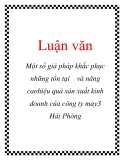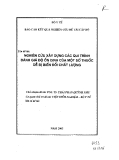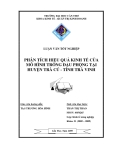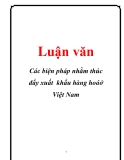Original article
Experimental research in ageing holm oak (Quercus ilex L.) coppices: preliminary results
Orazio la Marca*
Pasquale A. Marziliano Nicola Moretti
Istituto di Assestamento e Tecnologia forestale (IATF), Università di Firenze, Via S. Bonaventura n° 13 - I-50145, Florence, Italy
(Received 23 September 1996; revised 9 January 1997; accepted 17 September 1997)
Abstract - The initial data of a long-term research programme aimed at determining the silvi- cultural choices for management of ageing holm oak coppices are reported. The various treatments being tested are the following: treatments A and B, respectively, with 50 and 250 reserve trees per hectare, all of the same age; treatment C with 140 reserve trees per hectare, with three different ages; treatment D, conversion into high forest; and treatment E, natural evolution (the control). A total of 15 permanent plots were established (five treatments x three replicates) and the exper- imental design used is that of randomized blocks. The results presented regard the structural development of the coppice during the first 2 years after coppicing. Regeneration from seed showed a significant correlation with treatment. Data relative to the characteristics of the stands existing before the various interventions also are given. Such preliminary results need further peri- odical observations. (© Inra/Elsevier, Paris.)
Quercus ilex L. / coppice / regeneration / cutting method / snow breakage
Résumé - Expérimentation concernant les taillis vieillis de chêne vert (Quercus ilex L) : premiers résultats. Les résultats obtenus et ici présentés font partie d’un projet de recherche dont l’intention est d’individualiser des possibles options de culture pour les taillis de chêne vert vieillis. On a confronté les cinq thèses suivantes (avec trois répétitions) : les thèses A et B avec respectivement 50 et 250 réserves par hectare ayant toutes le même âge ; la thèse C avec 140 réserves par hectare, ayant trois âges différents ; la thèse D, conversion en futaie ; la thèse E, évolution naturelle. Les résultats exposés concernent l’évolution du peuplement pendant les deux premières années du cycle productif. Pour ce qui concerne la regénération, la présence des semis semble être favorisée par un couvert pas trop excessif des réserves. Il s’agit malgré tout de résultats préliminaires qui dérivent de parcelles d’échantillonage permanentes où, chaque année, on réalisera des reliefs. (© Inra/Elsevier, Paris.)
Quercus ilex L. / taillis / regénération / méthode de coupe / bris de neige
* Correspondence and reprints E-mail: IATF@cesit l.unifi.it
1. INTRODUCTION
sideration the spread of this species over the last 40 to 50 years, it is believed that the surface area covered by holm oak woods is increasing. On the Gargano head- land, holm oak coppices form units, often of considerable extension, which in gen- eral coincide with highly degraded soils. In some particularly impervious areas, the holm oak is the dominant species. This species can be found isolated or in small groups on slopes with a southern expo- sure up to the highest elevations of the Gargano headland (around 1 000 m a.s.l.). Until 40 to 50 years ago, the most com- mon management method for the holm oak was coppicing with few reserve trees per hectare, in order to satisfy the high demand for fuelwood and for charcoal production. The coppicing, carried out at short intervals (the rotation period was 15 years), together with the practice of grub- bing (to increase the quantity of wood to be removed at the end of each cycle), resulted in some zones in a notable degra- dation.
Holm oak woods have played and con- tinue to play a key role in soil conservation in protecting the soil from excessive inso- lation, leaching and erosion, even in extremely difficult geomorphological con- ditions.
In ancient times the holm oak was con- sidered a sacred tree. Reverence for this tree probably derives from its importance to the economy, uncommon vigour and longevity as well as its modest require- ments when grown both as a coppice or high forest. As noted by Pavari [19], and still today, many place names in Italy are in reference to this species. Holm oak wood was considered as an optimum fuel, as it still is today, and also was used to make tools and other objects subject to considerable wear. Its bark was used in the tanning industry, and the acorns and brushwood were used for food and bed- ding in the breeding of both wild and domestic animals.
In spite of the human intervention of replacing the holm oak with other species where pedological and geomorphological conditions allow, due to its uncommon resilience in unfavourable conditions and its capacity to colonize the most impervi- ous areas, the holm oak justly remains one of the species characteristic of the Mediter- ranean landscape. As observed by Pignatti [20], in a broad area of the Mediterranean region, holm oak stands represent the potential natural vegetation. In addition, these stands also represent a rare exam- ple of equilibrium in the interaction between natural factors and anthrophic activity.
With the decrease in anthropic pres- sure and due to the considerable capacity of regeneration characteristic of this species, the general situation of holm oak coppices has improved considerably as regards canopy closure and growing stock, and in the best edaphic conditions in regard to biodiversity.
The main problem to be confronted in forestry regarding management practices concerns the choice of silvicultural meth- ods suitable for the new economic and environmental situations in which holm oak coppices are found, in particular within the National Park of the Gargano. Few references appear in the research literature regarding holm oak formations. Interesting studies on holm oak carried out in France do provide management indications of general application [2, 8-13, 21]. Studies on biomass estimation equa- tions for individual holm oak were devel- oped in Spain [6, 7] and in Italy [4, 5]. A
On the Gargano headland (south-east- ern Italy), in addition to colonizing the low-lying areas at the edges of agricul- tural land, holm oak also tends to colo- nize the internal areas on sunny exposures up to relatively high elevations (> 800 m above sea level [a.s.l.]). Taking into con-
slope with a southern exposure where calcare- ous outcrops frequently occur. According to the FAO classification, the soils belong to Chromic cambisols. The climate is of Mediter- ranean type, with precipitations close to 650-700 mm/year, high rates of atmospheri- cal humidity and 3 months of summer aridity (sensu Bagnouls-Gaussen). The coppice is located on steep slopes (around 40 % inclina- tion). The experimental plots delineated for this study were chosen in an ageing coppice around 45 years old which, during the sum- mer months, was normally used as pasture land. The coppice was dominated by holm oak with a sporadic presence of flowering ash (Fraxi- nus omus) and European hophombeam (Ostrya carpinifolia). The traditional management had a short rotation period (15 years) and release of 60-70 reserve trees per hectare. Before the sil- vicultural interventions (February 1993), the holm oak stand had a high density of stems of resprout origin (mean stand density 6 300 stems/ha, of which about 70 reserve trees). The number of shoots per stump was 5.5. The diam- eter at breast height of shoots was 9.5 cm; basal area 44 m2·ha-1 and volume about 200 m3·ha-1. Undergrowth in the study area is repre- sented mainly by Asplenium onopteris, Asple- nium trichomanes, Cyclamen neapolitanum and Ruscus aculeatus, all species typically found in stands of holm oak.
survey on the potential wood production and coppice rotations of holm oak has been carried out by Hermanin and Pollini [16] in Tuscany, Italy. A research on veg- etative regeneration during the first 3 years after coppicing of Quercus ilex in the Maremma Nature Park (Tuscany, Italy) has been studied by Giovannini et al. [15]. More recently in Italy, within the MED- COP project (Improvement of coppice forests in the Mediterranean region), other research on holm oak coppices has been carried out [1, 14, 17].
The main objective of the study (in the long term) is to compare various types of manage- ment methods applied to ageing holm oak cop- pice.
The wind storm that occurred in Gargano at the end of August 1994 (wind speed around 150 km·h), and the excep- tional snowfall at the beginning of Jan- uary 1995 (over 120 cm of snow with den- sity between 0.25 and 0.30 g·cm-3), offered the opportunity to value the mechanical resistance of studied stands to the meteoric events of extraordinary inten- sity.
The experimental design adopted is that of randomized blocks. The treatments compared are: treatment A: coppice with 50 even-aged (40 years old) reserve trees per hectare; treat- ment B: coppice with 250 even-aged (40 years old) reserve trees per hectare; treatment C: coppice with 140 uneven-aged reserve trees per hectare, of three different ages - 80 of 40 years and 60 from 55 to 70 years; treatment D: conversion into high forest, obtained with the release of a great number (about 2 000) of trees to gain a transition high forest; treatment E: natural evolution (control).
2. MATERIALS AND METHODS
In February 1993, a total of 15 permanent plots were established (five treatments x three replicates). The plots were square in shape, each with a surface area of 1 600 m2. They were separated from each other by a distance of around 10 m on all sides in order to avoid a ’border effect.’
The holm oak coppice used for the present study is located in Monte S. Angelo (Promon- tory of the Gargano in southern Italy on a peninsula of the Adriatic coast). The holm oak stands cover about 2 500 ha. The coppice is found at an altitude of around 650 m a.s.l. on a
The present study in the Gargano head- land, initiated in 1993, is aimed at pro- viding experimental results on which to base silvicultural choices (natural evolu- tion, conversion into high forest, coppice management) regarding the management of ageing holm oak coppices at more or less maximal density. The effects of reserve trees (from 50 to 250) on the development of seedlings and shoots dur- ing the first 2 years after coppicing are examined here. The treatments to be con- fronted are suitable for the new economic and environmental situations (national park) in which these holm oak coppices are found.
The choice of the reserve trees to be left standing was based on good development and shape of the tree (this criterion led to decreas- ing ’quality’ as their number increased).
After coppicing (March 1993), all of the plots relative to treatments A, B and C were surrounded by barbed wire to protect the young shoots from free-roaming livestock.
Before cutting (i.e. the silvicultural inter- vention), the inventory of the tree populations in each of the 15 plots was taken. The height/diameter relationship was determined on the basis of measurements carried out on 100 trees, selected on the basis of representative criteria from among all the diameter classes. These trees have been used also to determine a single-entry volume table, showing the vol- umes and the fresh and dry weight of the trees up to 3 cm in diameter (excluding brushwood).
In August 1993 a planimetric drawing showing the position of each reserve tree (fig- ure 1) was made for each of the plots in which
among the shoots. In fact, in December 1993 all the shoots were marked at the base with indeli- ble paint, so that it was possible to note on each stump if there were any new shoots from the growing season following the first.
3. RESULTS
The main dendrometric parameters before and after the cutting together with the entity of the mass removed are shown in tables I, II and III for each plot.
treatments A, B and C were adopted. In each plot a transect diagonal with a NE-SW direc- tion (20-m long and 1-m wide) was drawn and mapped. For each species, the positions of all the seedlings and stumps in each transect were indicated so that their evolution over the period of the study could be followed, including the effect of the shading potential of the reserve trees. In this regard, in the treatment plots A, B and C, 30 reserve trees of different ages were selected around which concentric plots were drawn, each having a radius up to three times that of the radius of the canopy of the reserve tree. A detailed inventory of the seedlings and shoots in these concentric areas was also made so that their evolution could be followed (fig- ure 1).
The analysis of variance (ANOVA) carried out on the data for the number of stumps, total number of shoots per ha and number of shoots per stump before the sil- vicultural intervention show that there were no significant differences in any of these parameters. The average values for the number of stumps, total number of shoots per hectare and number of shoots per stump are given in table IV for each treatment together with the relative statis- tical indices calculated from the collected data.
3.1. Construction of volume table
The data collected on the coppice after cut- ting concerned the seed and vegetative regen- eration. The inventory on the seed regenera- tion was carried out both for the 20-m2 transects and the concentric plots. In December 1993 and November 1994, various dendro- metric features (collar diameter in mm and height in cm) were measured on all the seedlings present in the transects and in the concentric plots. In the course of the second sampling (November 1994), a check was also made to see if there were any new seedlings and whether any of the seedlings noted in the first sampling had died. The location of each seedling in the concentric plots was related to the projection of the canopy of the reserve tree. This was accomplished by specifying classes of distance from the edge of the projection of the canopy, each 1-m wide; the increasing dis- tances outward from the edge of the canopy were indicated with positive numbers, while those under the canopy going inward towards the tree were indicated with negative numbers (figure 2).
Using the measurements carried out on a sample of 100 trees, the following semi- logarithmic equation was employed to cal- culate the height curve (figure 3) of the sampling stand before the various silvi- cultural interventions:
where H = height and D130 = diameter at breast height in cm.
The volumes of the shoots taken in the sample are a function of their diameter at breast height (130 cm). The volume curve (figure 4) was calculated from the fol- lowing model:
Data on vegetative regeneration were col- lected for all the stumps present in the transect and in the concentric plots. The number of stumps per hectare were determined, in August 1993, from the complete census of each plot. The position of each stump in the concentric plots was related to the projection of the canopy of the reserve tree, in order to evaluate any possible differences in growth or mortality of the shoots. In December 1993 and November 1994, the number of shoots per stump, the col- lar diameter of all the shoots and the total height of 15 shoots for each stump were determined. The sampling done in the 2nd year (Novem- ber 1994) determined the mortality occurring
where V = volume and D130 = diameter at breast height in cm.
Finally, the volume table (table V) was transformed into a weight determination table. The ratio between the weight of the timber and its volume was calculated for 300 samples collected from 100 trees at different heights (at the base of the tree,
This equation expresses the volume, including the bark, of the shoots (trees) in m3 (with a 3-cm topping) as a function of their diameter at breast height, expressed in cm. The correlation coefficient obtained was very good (R2 = 0.967).
3.2. Gamic and vegetative regeneration
at half-height and at the top of the tree). Both the volumetric mass (ratio between fresh weight and fresh volume) and the basic density (ratio between the dry weight and the fresh volume) were calculated. The fresh weights were those measured on the same day as the cutting (February 1993), while the dry weights were those determined by drying the samples to con- stant weight in an oven at 85 °C.
The volumetric mass was 1.169 g·cm-3 and the basic density was 0.746 g·cm-3. The weight determination table (table V), therefore, was derived from the preced- ing volume table simply by multiplying the volume values by 1 169 and 746, respectively. In this way, one obtains the fresh and dry weights expressed in kilo- grams as a function of tree diameter. The data collected on seed regenera- tion made it possible to determine the mor- tality among seedlings, the number of seedlings per hectare in the various treat- ments during the first 2 years after the sil- vicultural interventions (together to pre- existent seedlings). In addition to the seedlings recorded in the first years, approximately 1 000 were noted in the fol- lowing year. ANOVA was conducted on all parameters considered. The number of seedlings per hectare, diameter at the col- lar and their height are shown in table VI. Mortality was found to be 11.0 % in treat- ment A, 13.5 % in treatment B and 7.3 % in treatment C. ANOVA showed signifi- cant differences (P = 0.05) in the number of seedlings between treatments A and C
The data collected on vegetative regen- eration made it possible to determine the average diameter and height of the shoots and the number of shoots per stump in 1993 and 1994.
in both the 1st and 2nd years, while no significant differences in the dimensions of the seedlings were found between the var- ious treatments. The study on the pres- ence of seedlings in relation to the dis- tance from the canopy of the reserve trees (table VII) has so far revealed no signifi- cant datum. However, the greatest con- centration of seedlings seems to be found (in all treatments) around the edge of the canopy.
The average number of stumps per hectare, after cuttings, was found to be 1 108 for treatment A, 865 for treatment B and 991 for treatment C. After the silvi- cultural interventions, since treatments A, B and C differ in the number of reserve
trees per hectare, clearly the number of stumps left for vegetative regeneration is obtained by subtracting the number of reserve trees from the total number of stumps.
number of shoots per hectare in treatment A is still significantly higher than that in other treatments, while there are no sig- nificant differences between the height of shoots and their diameters for the various treatments.
The data collected in the concentric plots made it possible to determine pos- sible differences in diameter and number of shoots between the areas falling under the canopy of the reserve tree (shoots shaded by the tree) and those falling out- side the influence of the canopy (free shoots). The total number of stumps sur- veyed in the 30 concentric plots was 364. The processed data (table X) show that, where diameters are concerned, values slightly increasing from the trunk of the reserve trees outwards as far as the edge of the canopy projection, from the edge of the canopy outwards the findings take on a random character.
3.3. Damage from meteoric events
Two years after the cutting, almost all of the stumps were found to have living shoots. Some stumps without living shoots (four stumps per hectare) were found only with treatment A. The number of shoots per stump, in 1994, was 35.8 for treatment A, 31.2 for treatment B and 27.8 for treat- ment C (table VIII). About 35 % of the holm oak shoots present in the 1st year following felling died (table IX). Gener- ally, the dead shoots were found under the canopy and growing in anomalous direc- tions. At the start of the second vegeta- tive season, a fresh production of shoots occurred on the stumps (an average of about 11 shoots per stump). During the next survey these new shoots will be observed, with their modest dimension (the fact that they are dwarfed by other shoots), to determine whether they are in a condition to develop or are destined to fail.
Analysis of variance revealed that, at a distance of 2 years from coppicing, the
Table XI indicates the number of trees per hectare and the average diameter of the trees standing before the two meteoric
70. On the basis of these observations, in first approximation, the critical value of the height/diameter ratio for the shoots of holm oak is around 70.
4. DISCUSSION AND CONCLUSION
events cited earlier, together with the num- ber of trees uprooted or broken per hectare and the remaining number of trees per hectare after the said events. The data show that the intensity of the damage var- ied considerably depending on the treat- ment chosen (number of reserve trees per hectare). In both absolute and relative terms, the greatest damage was found in the plots in which treatment B (250 reserve trees per hectare) was used. On the aver- age, more than 50 % of the reserve trees were broken or uprooted, with an average volumetric loss of 7 m3·ha-1.
The emergence and growth of the seedlings took place chiefly in the year of cutting and during the first vegetative sea- son of the coppice. The number of seedlings emerging in the course of the 2nd vegetative year proved to be rather small.
In both cases, treatments A and B, the damaged trees belonged to the lowest diameter classes. With respect to the aver- age diameter of the trees in the individual plots, the damaged trees always had a lower diameter.
Damage in the plots where treatment C (reserve trees of different ages) was used also was relatively low ( 12 % of the trees), with a volumetric loss of 1.39 m3·ha-1.
Regeneration from seed, which is still abundant in all treatments (on average there are over 20 000 seedlings per hectare), showed a significant correlation with the treatment used. In treatment A (50 reserve trees per hectare), a larger number of seedlings was noted as com- pared with the other treatments. A higher proportion of reserve trees, therefore, did not make for the emergence of a larger number of seedlings. Most likely, many reserve trees in the stand have a negative effect on the survival of the young seedlings, due perhaps to excessive shad- ing. Little is known about the performance of holm oak seedlings as a function of the cover made by the canopy of the reserve trees, the latter being well spread out and stratified - insufficient research has been done on this point. Holm oak seedlings under cover from deciduous trees seem to have a fair resistance because they have the benefit of ample light during the win- ter [3]. As the experimental work proceeds a detailed study will be made of the influ- ence of the canopy of the reserve trees on the mortality and dimensional develop- ment of seedlings.
In the plots in which treatment A (50 reserve trees per hectare) was adopted, an average of 37 % of the trees were broken or uprooted during the two meteoric events. It should be pointed out, however, that this percentage of damage is mainly the result of that occurring in a single plot where the diameters of the trees were small (in this plot 75 % of the trees were damaged). The average volumetric loss is 1.59 m3·ha-1.
The damage caused by the two mete- oric events in the plots where treatments D and E (conversion to high forest and the control, in percent) were used was not high (20 % and 3 %, respectively, of the stand- ing trees). In absolute terms, instead, the loss was of 413 unity (27.38 m3·ha-1) for the conversion into high forest and of 196 unity (11.37 m3·ha-1) for the control.
The height/diameter ratio of the bro- ken trees ranged from 68 to 75, while that of the trees still standing ranged from 57 to
Another interesting fact is the low mor- tality among seedlings emerging in the coppice with uneven-aged reserve trees. In this connection, certain authors [3, 18, 19] suggest that this form of management
seems to favour the regeneration of holm oak, since cutting the trees releases a large amount of the acorns capable of germi- nating and becoming established.
Vegetative regeneration tends to regain upper-air levels very quickly. By the 2nd year, shoot height will exceed 120 cm, and contacts between the canopies of shoots from different stumps are already observable. In 2 years time, the shoots will be entirely under cover.
Apart from these considerations, this study represents a contribution to the task of acquiring an exact understanding of sil- vicultural techniques that are best suited to the achievement of a specific purpose, and of the effects of operations conducted in stands. Given the socio-economic condi- tions obtained in the tract of country con- sidered, it is evident that coppice man- agement for the production of fuelwood not only constitutes the traditional forest use in these parts but supplies a commod- ity for which there is still a market demand.
Coppices with fewer reserve trees have produced a greater number of shoots, the latter also having an average diameter and average height greater (though not to any significant extent) than in other treatments. A coppice with uneven-aged reserve trees produces the lowest number of shoots per stump, and the average diameters will be smaller.
At a distance of 2 years from the begin- ning of this research, therefore, it seems that, wherever a smaller number of reserve trees has been, more shoots have become established and vegetative regeneration has resulted in greater increments. Two years from coppicing it becomes clear that a high reserve tree-to-coppice ratio makes for excessive shading and does nothing to increase regeneration from seed.
The holm oak coppice has undoubtedly been an important component of the Gargano landscape since ancient times. Coppices consisting of this species have been in centuries-long equilibrium with the environment - indeed, have charac- terized that environment. For this reason, too, even a partial return to this form of management is desirable. ’Every forest,’ said Patrone, ’has its story.’ Within the area now declared a national park, it is essential to respect history and to turn this history to good account. In any case, Framework Law No. 394/91, the Parks Act, creates incentives for, and in other ways promotes, traditional activities car- ried on by man in the tract of country that has been declared a park.
trees; conversion into high forest; and allowing natural evolution to proceed unhindered.
It may be worth repeating, however, that the practice of leaving a large number of reserve trees inevitably entails accept- ing less rigour in the choice of trees to be left standing; and this can prove highly dangerous when one considers the dam- age to the coppice caused by poor weather conditions.
The ’coppice problem’ can, as a gen- eral rule, be approached via differing man- agement formulas: coppice with reserve
The results show that the holm oak cop- pice meets all the requirements for con- tinuing with this form of management. The number of reserve trees to be left standing should also be governed by the shoot-bearing capacity of the stumps and by the abundance and frequency of acorn production. In this respect, the holm oak has excellent characteristics both in terms of agamic regeneration and in terms of fruiting.
In conclusion, this study on manage- ment options conducted in a holm oak stand in the Gargano has made it possi- ble, albeit in strictly provisional terms, to discern differences among the effects of the respective management practices.
ACKNOWLEDGEMENTS
des recherches récentes, Rev. For. Fr. 40 (4) (1988) 302-313.
[10] Ducrey M., Quelle sylviculture et quel avenir pour les taillis de chêne vert (Quercus ilex L.) de la Région méditerranéenne française? Rev. For. Fr. 44 (1)(1992) 12-34.
[9] Ducrey M., Peut-on rendre la yeuseraie moins combustible ? Rev. For. Fr. 42, n° spécial ’Espaces forestiers et incendies’ (1990) 202-206.
The authors have all contributed equally to the drawing up of this paper. The research has been realized with CEE funds MEDCOP pro- ject. The operative unit was coordinated by Prof. Orazio la Marca. Thanks are due to Anto- nio Palumbo for his assistance in data collec- tion. Sincere appreciation is also expressed to the local government (’Amministrazione Comunale di Monte S. Angelo’), the Depart- ment of Forestry (’Ispettorato Ripartimentale delle Foreste’) and the forest rangers of the Gargano (’Corpo Forestale dello Stato’) for their collaboration.
[11] Ducrey M., Boisserie M., Recrû naturel dans des taillis de Chêne vert (Quercus ilex L.) à la suite d’exploitations partielles, Ann. Sci. For. 49 (1992) 91-109.
REFERENCES
[12] Ducrey M., Toth J., Effects of cleaning and thinning on height growth and girth increment in holm oak coppices (Quercus ilex L.), Vege- tatio 99-100 (1992) 365-376.
[13] Ducrey M., Turrel M., Influence of cutting methods and dates on stump sprouting in holm oak (Quercus ilex L.) coppices, Ann. Sci. For. 49 (1992) 449-464.
[14] Fabbio G., Manetti M.C., Puxeddu M., La lec- ceta: un ecosistema ’in riserva’. Atti VI Con- gresso nazionale Società italiana di Ecologia, 11-14 September 1996, Naples, Italy, 1996.
[15] Giovannini G., Perulli D., Piussi P., Salbitano F., Ecology of vegetative regeneration after coppicing in macchia stands in central Italy, Vegetatio 99-100 (1992) 331-343.
[1] Amorini E., Bruschini S., Cutini A., Fabbio G., Struttura e produttività di popolamenti di leccio in Sardegna. Atti VI Congresso nazionale Soci- età italiana di Ecologia, 11-14 September 1996, Naples, Italy, 1996.
Torino, Italy, 1995.
[2] Barbero M., Loisel R., Les Chênaies vertes du Sud-Est de la France méditerranéenne : valeurs phytosociologiques, dynamiques et potentielles, Phytocoenologia 11 (2) (1983) 225-244. [3] Bernetti G., Selvicoltura speciale, UTET,
[16] Hermanin L., Pollini M., Produzione legnosa e paesaggio. Considerazioni sull’ampiezza del turno in cedui di leccio, Cellulosa e Carta 2 (1990) 6-10.
[4] Brandini P., Tabacchi G., Modelli di previsione del volume e della biomassa per polloni di lec- cio e di corbezzolo in boschi cedui della Sardegna meridionale, Comun. Ricerca ISAFA 96 (1) (1996) 59-69.
For. Ital. 1-3 (1942) 33-36.
[17] La Marca O., Marziliano P.A., Moretti N., Pig- natti G., Dinamica strutturale e floristica in un ceduo di leccio, Ann. Accad. Ital. Sci. For. XLIV (1995) 235-256. [18] Merendi A., Boschi cedui e matricinatura, Ri.
390-398.
[5] Bruno F., Gratani L., Manes F., Primi dati sulla biomassa e produttivita della lecceta di Castel- porziano (Roma): biomassa e produzione di Quercus ilex L, Ann. Bot. 35-36 (1976-77) 109-118. [19] Pavari A., Il leccio od elce, Alpe 17 (8) (1930)
Torino, 1994.
[6] Canadell J., Rodà F., Root biomass of Quer- cus ilex in a montane Mediterranean forest, Can. J. For. Res. 21 (12)(1991) 1771-1778. [7] Canadell J., Reba M., Andrés P., Biomass equa- tions for Quercus ilex L. in the Montseny Mas- sif, northeastern Spain, Forestry 61 (2) (1988) 137-147.
[20] Pignatti S., Ecologia del paesaggio, UTET,
[8] Ducrey M., Sylviculture des taillis de Chêne vert. Pratiques traditionnelles et probiématique [21] Toth J., Ducrey M., Turrel M., Protocole d’étude du dépressage dans des taillis de Chêne vert âges de 4 à 25 ans en vue de leur conver- sion en futaie sur souche, Station de Sylvicul- ture méditerranéenne, Avignon, Inra, Docu- ment n° 19/86, 1986, 26 p.




































